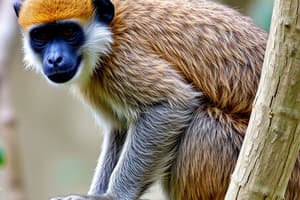Podcast
Questions and Answers
What does the superfamily end in?
What does the superfamily end in?
oidea
What does the Family end in?
What does the Family end in?
dae
What does the subfamily end in?
What does the subfamily end in?
nae
Who belongs in Suborder Strepsirrhini?
Who belongs in Suborder Strepsirrhini?
Who belongs in suborder Haplorrhini?
Who belongs in suborder Haplorrhini?
In Suborder Strepsirrhini, what are the infraorders?
In Suborder Strepsirrhini, what are the infraorders?
In Infraorder Lemuriformes, what is the superfamily?
In Infraorder Lemuriformes, what is the superfamily?
In Infraorder Lorisiformes, what is the Superfamily?
In Infraorder Lorisiformes, what is the Superfamily?
In Superfamily Lemuroidea, what are the families?
In Superfamily Lemuroidea, what are the families?
In Superfamily Lorisoidea, what are the families?
In Superfamily Lorisoidea, what are the families?
Lemurs belong to which Suborder, Infraorder, and Superfamily?
Lemurs belong to which Suborder, Infraorder, and Superfamily?
Where are Lemuriformes found?
Where are Lemuriformes found?
All primates are members of Class _____ and Order _______
All primates are members of Class _____ and Order _______
Tarsiers were problematic for taxonomists for a long time. In the traditional classification scheme based on morphology, they were grouped with ________, while in modern classification systems based on genetics, they are included within the suborder ________.
Tarsiers were problematic for taxonomists for a long time. In the traditional classification scheme based on morphology, they were grouped with ________, while in modern classification systems based on genetics, they are included within the suborder ________.
Name two key nocturnal adaptations.
Name two key nocturnal adaptations.
Flashcards are hidden until you start studying
Study Notes
Primate Taxonomy Overview
- Superfamilies in primate taxonomy end with the suffix -oidea.
- Families are designated by the suffix -dae.
- Subfamilies conclude with the suffix -nae.
Suborders of Primates
- Strepsirrhini includes lemurs and lorises.
- Haplorrhini comprises tarsiers, New World monkeys, Old World monkeys, apes, and humans.
Infraorders
- Strepsirrhini is divided into two infraorders: Lemuriformes and Lorisiformes.
Superfamilies and Families
- Infraorder Lemuriformes contains the superfamily Lemuroidea, which includes the families:
- Cheirogaleidae
- Lepilemuridae
- Lemuridae
- Indriidae
- Daubentoniidae
- Infraorder Lorisiformes includes the superfamily Lorisoidea, which comprises:
- Lorisidae
- Galagidae
Habitat and Distribution
- Lemurs are endemic to Madagascar, found exclusively in the region.
Classification Structure
- All primates belong to Class Mammalia and Order Primates.
Tarsiers' Classification Dilemma
- Traditionally, tarsiers were classified with prosimians based on morphology.
- In modern taxonomy, they are classified within the suborder Haplorrhini based on genetic data.
Nocturnal Adaptations
- Key adaptations for nocturnal living include:
- Large eye orbits to enhance vision in low light.
- Tapetum lucidum in the retina, which reflects light and increases night vision.
- Typically small body size, aiding in agility and stealth.
Studying That Suits You
Use AI to generate personalized quizzes and flashcards to suit your learning preferences.



